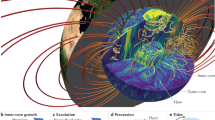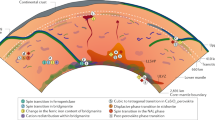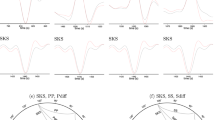Abstract
IT has been argued1 that the data on the Q value of the Earth's mantle do not militate against convection currents because the range of frequency over which Q has been proved constant in the laboratory (10−4<f<106 Hz) does not lie entirely within that which can be explained by the Lomnitz law2 of creep in rocks (10−8<f<1 Hz). The Lomnitz law is characterized by a decreasing rate of creep that forbids convection and McCann rightly points out that according to this law the mechanism which accounts for the constant Q over the laboratory proven range is inexplicable and so convection is, in fact, allowed as the law is not representative of rocks thought to make up the Earth's interior. There are several comments to be made on this reasoning. (i) The processes responsible for damping in the mantle are not the same as those dominant in the laboratory. Experiments made at atmospheric pressure are dominated by microcracks, as noted by Anderson3 and Orowan4. These cracks are closed by pressures of only 2 or 3 kbar, corresponding to a depth of approximately 10 km. Thus, laboratory data that show a wide range of frequency-independent Q are not of any use at depth unless special experimental arrangements are made. (ii) Most experiments on damping are inherently unsatisfactory because they are made on the width of the damping peak in amplitude, that is liable to be broadened by numerous effects (ref. 2, page 334). (iii) Lomnitz5 in his original work used a torsion method to investigate the anelastic response of rocks to a suddenly applied stress, P, and arrived at the law  where ε is the strain at time t, μ is the rigidity, and q, a are constants. It is an empirical creep law, and needs connecting with an explicitly stated damping process before any fundamental connexion between the two can be attempted6. Indeed, there may well be no connexion between the creep processes and the damping processes operative in the Earth, as they are rate-controlled in different ways on an atomic scale.
where ε is the strain at time t, μ is the rigidity, and q, a are constants. It is an empirical creep law, and needs connecting with an explicitly stated damping process before any fundamental connexion between the two can be attempted6. Indeed, there may well be no connexion between the creep processes and the damping processes operative in the Earth, as they are rate-controlled in different ways on an atomic scale.
This is a preview of subscription content, access via your institution
Access options
Subscribe to this journal
Receive 51 print issues and online access
$199.00 per year
only $3.90 per issue
Buy this article
- Purchase on Springer Link
- Instant access to full article PDF
Prices may be subject to local taxes which are calculated during checkout
Similar content being viewed by others
References
McCann, C., Nature, 228, 656 (1970).
Jeffreys, H., The Earth, fifth ed. (Cambridge University Press, 1970).
Anderson, D. L., Geophys. J. Roy. Astron. Soc., 14, 135 (1967).
Orowan, E., Geophys. J. Roy. Astron. Soc., 14, 191 (1967).
Lomnitz, C., J. Geol., 64, 473 (1956).
Gordan, R. B., Geophys. J. Roy. Astron. Soc., 14, 163 (1967).
Murrel, S. A. F., Geophys. J. Roy. Astron. Soc., 14, 4 (1967).
Wesson, P. S., Quart. J. Roy. Astron. Soc., 11, 312 (1970).
Author information
Authors and Affiliations
Rights and permissions
About this article
Cite this article
WESSON, P. Convection and the Constant Q-Mechanism. Nature 232, 251–252 (1971). https://doi.org/10.1038/232251a0
Received:
Issue Date:
DOI: https://doi.org/10.1038/232251a0
Comments
By submitting a comment you agree to abide by our Terms and Community Guidelines. If you find something abusive or that does not comply with our terms or guidelines please flag it as inappropriate.



